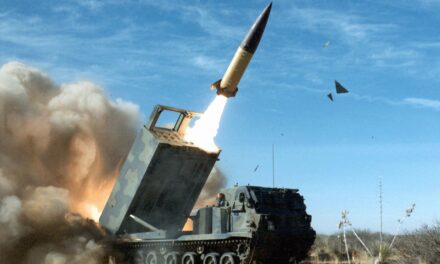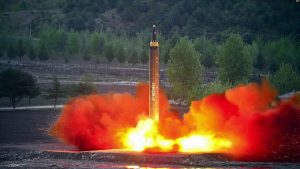We support our Publishers and Content Creators. You can view this story on their website by CLICKING HERE.
President Joe Biden’s administration will “do everything possible” during its remaining time in office to help Ukraine “fight through 2025” and obtain “a position of strength” in potential peace talks, Secretary of State Antony Blinken vowed on Tuesday. The administration has recently taken some important steps in this direction, including permitting missile strikes in Russia.
But there is more Biden — and Congress — can do before January 20.
Though Ukrainian soldiers continue to fight hard, the war is trending in a troubling direction. Russia’s rate of advance, while still relatively modest, has accelerated each month since June. Russian troops are now taking an average of over 20 square kilometers per day, their fastest pace since 2022. More concerning than these territorial gains themselves is what they say about the state of Ukrainian forces. A shortage of manpower, particularly infantry, increasingly stresses the Ukrainian defense. Kyiv is losing soldiers faster than it can replace them. The country’s mobilization rate has dwindled, and too many under-trained soldiers are suffering casualties or going AWOL.
Meanwhile, as temperatures drop, Moscow has renewed its efforts to destroy Ukraine’s energy infrastructure, already decimated by prior missile and drone strikes. This winter will likely be the toughest Ukraine has faced yet. In a pessimistic scenario, severe blackouts could trigger another refugee crisis.
Vladimir Putin seems to be betting he can grind down Ukraine enough to impose maximalist peace terms. The conditions pushed by the Kremlin would restrict Ukraine’s geopolitical autonomy and leave the country vulnerable to future Russian aggression. Although Russia’s military and economy also face growing challenges, the concern is that Ukrainian lines will break before the Russians run out of steam.
A related challenge is the uncertainty regarding future U.S. aid for Ukraine under President-elect Donald Trump, who seeks to broker a quick peace deal. Though he is unlikely to halt assistance entirely, a reduction is possible, perhaps in an ill-conceived bid to pressure Kyiv into concessions. Moscow likely hopes that its threats of escalation will encourage the incoming administration to be more cautious in supporting Ukraine and more amenable to Russian terms.
With all this in mind, the Biden administration has made some important decisions in recent weeks and months to put Ukraine in a better position heading into next year. In late September, Biden directed the Pentagon to “surge” its remaining congressionally allocated assistance to Kyiv before he leaves office. Notably, the president pledged an additional Patriot air defense battery to help Ukraine defend against Russian missile strikes.
Earlier this month, the administration permitted American contractors to maintain and repair military equipment inside Ukraine, expediting its return to service. In addition, Biden decided to give Kyiv antipersonnel landmines, intended to help stop Russian’s creeping infantry assaults.
And at long last, Biden loosened restrictions on Ukrainian strikes in Russia using American-provided ATACMS missiles. London, in turn, has similarly permitted strikes inside Russia using UK-supplied Storm Shadow missiles. Officials hope these strikes will help Ukraine hold onto territory it seized in Russia’s Kursk region last August as well as deter North Korea from sending additional troops to fight for Russia. Ukraine has wasted no time in striking high-value targets in and around the Kursk region.
These recent U.S. decisions, while belated, can make a positive contribution to the fight. Although Kyiv’s manpower shortage is its biggest problem, increased Western aid can help compensate for that weakness and reduce Ukraine’s casualty rate.
But Biden shouldn’t stop here. Plenty more can be done before his term is up.
For starters, Kyiv will need more missiles if it’s to take full advantage of the new policy on strikes in Russia. Ukraine’s missile stocks are relatively small, and some them will be intercepted by Russia. Although the Pentagon says it can’t spare many more ATACMS, the United States could provide other munitions, such as JASSM air-launched cruise missiles, an option the administration reportedly has considered. JASSM has a longer range than ATACMS and is available in larger numbers. At the same time, the Pentagon could place a large order for new ATACMS production for Ukraine, then push it to the front of the queue — something the administration reportedly has refused to do.
BM-21 Under Attack by Ukraine Drone
Furthermore, providing more artillery ammunition would ease the burden on Ukrainian infantry. While Ukraine has leaned on first-person view strike drones to help compensate for shortages of manpower and artillery, these drones aren’t a cure-all. U.S. production of 155mm artillery shells is expected to double to 100,000 rounds per month by summer 2025, enabling greater supplies to Kyiv. But Ukraine needs these munitions now, not later.
Washington should push South Korea, a significant producer of artillery ammunition, to consider indirectly providing additional shells to Ukraine via the United States, as Seoul did earlier in the war. The Pentagon should also consider front-loading U.S. deliveries by temporarily dipping a bit deeper into its existing stocks with the understanding that the difference can soon be recovered thanks to the imminent increase in production. This could allow Ukraine to fire higher volumes when they’re needed most. It would help hedge against a potential cut to U.S. aid under Trump.
In addition to ammunition, Kyiv needs more armored vehicles and other equipment to replace losses and kit out new and existing units. The Biden administration has pledged a significant number of vehicles over the last couple months — albeit mostly Humvees — and should continue this trend. Many Ukrainian units remain under-equipped. Filling this gap would improve their combat capability and help reduce casualties. Ideally, these additional deliveries will include more Bradley infantry fighting vehicles, which have performed excellently in Ukraine. But less-glamorous equipment would also be useful, such as aging M113 armored personnel carriers, thousands of which are sitting in long-term storage.
Finally, Congress needs to do its part, too. Biden has asked lawmakers to include additional Ukraine-related funding in the short-term budget bill currently under discussion. This funding would help ensure that Washington can continue supporting Kyiv through the end of the next fiscal year. Bipartisan support would send the Kremlin a powerful signal about U.S. resolve.
About the Author: John Hardie
John Hardie serves as deputy director of FDD’s Russia Program. His research focuses on Russian foreign and security policy, U.S. policy toward Russia and the post-Soviet space, and transatlantic relations. His byline has appeared in publications including Foreign Policy, Defense News, The National Interest, and C4ISRNET. John holds an M.A. in security studies from the Georgetown University School of Foreign Service and bachelor’s degrees in international relations, political science, and psychology from the University of Georgia.

 Conservative
Conservative  Search
Search Trending
Trending Current News
Current News 





